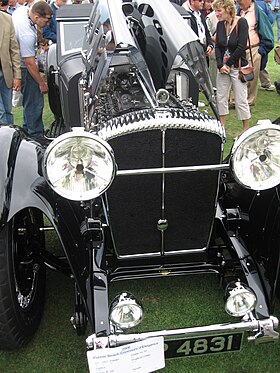Daimler Double-Six sleeve-valve V12
| Daimler Double-Six (50) | |
|---|---|
 |
|
| Overview | |
| Manufacturer | The Daimler Company Limited |
| Also called | Daimler Double-Six |
| Production | 1926-1930 |
| Combustion chamber | |
| Configuration | 60 degree V twelve-cylinder |
| Displacement | 7.136 litres (435 cu in) |
| Cylinder bore | 81.5 mm (3.2 in) |
| Piston stroke | 114 mm (4.5 in) |
| Cylinder block alloy | Cast iron, cast in blocks of 3 cylinders Alloy pistons running in light steel sleeve-valves |
| Cylinder head alloy | Cast iron? detachable, separate head for each block |
| Valvetrain | Sleeve-valves, double light steel sleeves operated by pushrod from chain-driven eccentric shafts in the engine block |
| Combustion | |
| Fuel system | Twin 7-jet Daimler carburettors with pre-heated air supply, petrol supplied by mechanical pump mounted near the carburettor. Ignition by two magnetos and battery and coil |
| Fuel type | Petrol |
| Oil system | Submerged pump, separate radiator |
| Cooling system | Water: belt-driven four-blade fan and radiator |
| Output | |
| Power output | 150 bhp (110 kW; 150 PS) @ 2,480 rpm |
| Chronology | |
| Predecessor | 57 hp inline six-cylinder |
| Successor | Double-Six 40/50 |
Daimler Double-Six piston engine was a sleeve-valve V12 engine manufactured by The Daimler Company Limited of Coventry, England between 1926 and 1938 in four different sizes for their flagship cars.
Daimler required an advanced new model to compete with Rolls-Royce's New Phantom of 1925. Though Packard had introduced its Twin-Six many years earlier it was to be a decade or more before luxury manufacturers like Rolls-Royce, Hispano-Suiza, Lincoln, Voisin and Lagonda made their own (and Packard returned to it). In fact by the mid-1930s flexible engine mountings and improved carburation had made so many cylinders unnecessary. What did return them to a certain level of popularity was the push for higher performance requiring higher crankshaft speeds. Daimler introduced their first 26 hp straight-eight in mid-1934 and their last (poppet valve) V12s were built in 1937 or 1938.
From 1929 Daimler Double-Sixes were distinguishable from the six-cylinder cars by a chromium bar down the centre of the radiator. A similar distinguishing mark was placed on the later Jaguar-made versions.
Aside from Daimler only Voisin in France ever attempted production of a sleeve-valve V12 engine. Voisin's production—between 1929 and 1937—was "minimal and spasmodic".
The same Daimler Double-Six name was used for the badge-engineered Daimler V12 engine used in the largest Daimlers between 1972 and 1997. Lofty England, a Daimler apprentice 1927–1932, joined Jaguar in 1946 and became its chief executive. He ensured the Double-Six name was used for the Jaguar V12 when installed in Daimler cars.
This engine was designed by consultant Chief Engineer L H Pomeroy (1883-1941) to achieve high power with quietness and, particularly, smoothness. Pomeroy made the engine by taking the cylinder blocks of two existing 25/85 hp Daimler engines and putting them on a common crankcase. Pomeroy was to be appointed managing director in 1929. The same design was produced in different sizes depending on the different engine displacements.
...
Wikipedia
